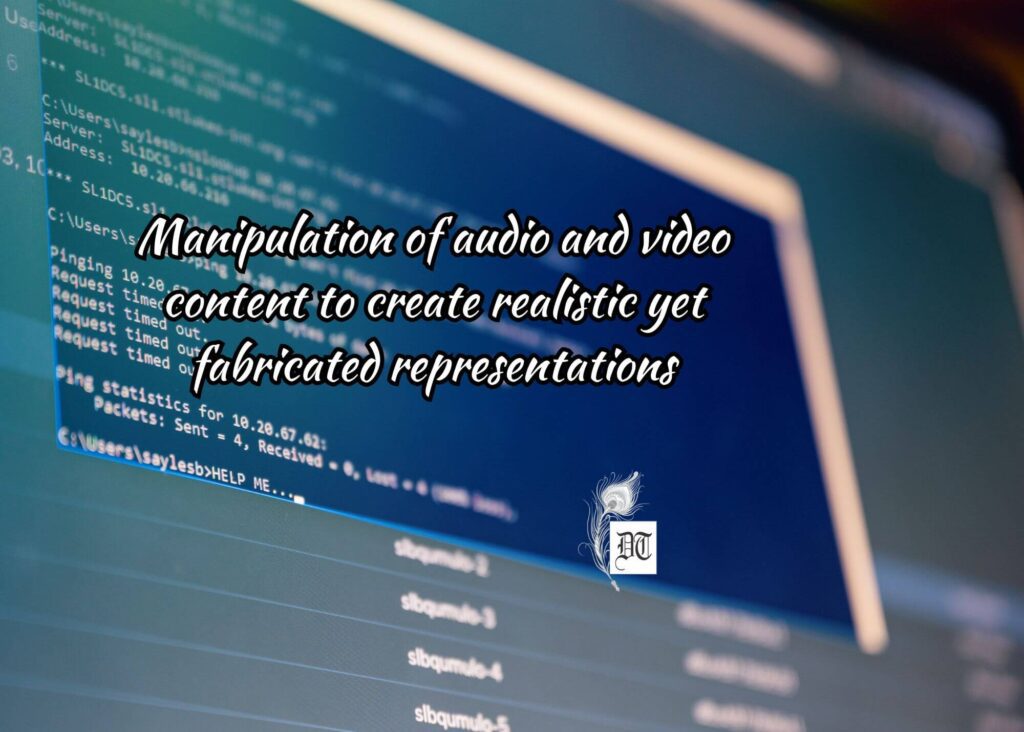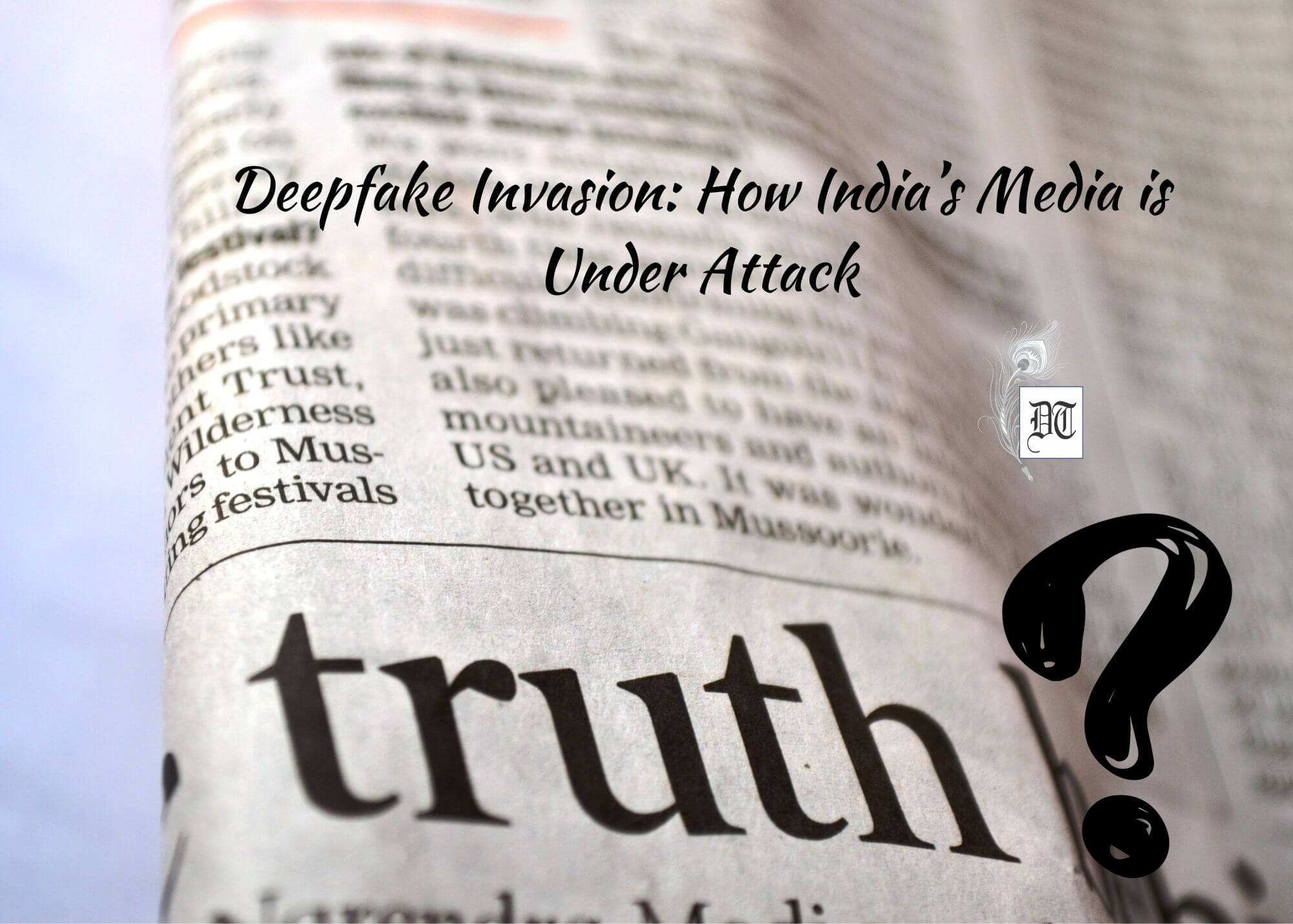Reading Time: 9 minutes
Deepfake technology in India poses threats to political integrity, information dissemination, and celebrity reputation. This article, by Arindam, advocates for a comprehensive approach involving technological advancements, regulatory frameworks, and public awareness—exclusively for Different Truths.

Deepfake technology has emerged as a significant threat to the integrity of digital content, raising concerns about the potential misuse of manipulated videos and images. In the context of Indian online media, the rise of fake news presents a unique set of challenges and risks. This article explores the phenomenon of deepfakes and its implications for Indian online media and provides examples and references to illustrate the gravity of the situation.
Understanding Deepfakes
Deepfakes are AI-generated content, often videos or images, created using deep learning techniques. These sophisticated algorithms manipulate and superimpose facial features onto existing footage, making it appear as though a person is saying or doing something they never did. The ease with which these forgeries can be created has led to concerns regarding their potential impact on public perception, political campaigns, and the credibility of media outlets.
Examples of Deepfakes in Indian Online Media
In India, the emergence of deepfakes poses a significant threat to various aspects of society, with political manipulation being a major concern. Deepfakes, or digitally manipulated videos created using artificial intelligence (AI) techniques, have gained prominence in recent years due to their ability to convincingly alter facial expressions, speech patterns, and even body movements in videos.
Political Manipulation
Deepfakes have the potential to manipulate political narratives, creating false scenarios that can influence public opinion. An example is a deepfake video where a politician appears to make controversial statements, causing a stir and affecting their reputation. This type of manipulation can have far-reaching consequences during elections and political campaigns. In a country as diverse and politically charged as India, where public sentiment plays a crucial role in decision-making, the impact of deepfake political manipulation is particularly concerning.
During elections, the spread of misinformation can be detrimental to the democratic process.
During elections, the spread of misinformation can be detrimental to the democratic process. Deepfake videos can be used to create fake speeches, interviews, or statements from political figures, leading voters astray and influencing their perceptions. The potential for such manipulations to incite violence or sway public opinion raises serious ethical and security concerns.
Social Media Influence
India has one of the largest user bases on social media platforms, making it a fertile ground for the dissemination of deepfakes. The speed at which information spreads on social media, coupled with the widespread use of messaging apps, creates an environment where deepfakes can quickly go viral and reach millions of people. This can lead to the rapid spread of false narratives, impacting public discourse and exacerbating social tensions.
Challenges for Detection and Regulation
Detecting deepfakes poses a considerable challenge, as they are often created using advanced AI algorithms that make them difficult to distinguish from authentic content. The lack of effective detection mechanisms makes it challenging for authorities to prevent the spread of deepfake content. Additionally, the legal framework in India may not be adequately equipped to handle the complexities of deepfake-related offences, highlighting the need for updated regulations.
Steps Towards Mitigation
To address the growing threat of deepfakes in India, there is a need for a multi-faceted approach. This includes investing in advanced detection technologies, enhancing cybersecurity measures, and fostering media literacy among the public. Collaborative efforts between tech companies, government agencies, and civil society organisations are essential to create a comprehensive strategy against the misuse of deepfake technology.
…as deepfake technology continues to advance, the potential for political manipulation in India becomes a pressing concern.
Finally, as deepfake technology continues to advance, the potential for political manipulation in India becomes a pressing concern. The government, technology industry, and society at large must work together to develop robust strategies for detecting and preventing the spread of deepfakes. By prioritising cybersecurity measures, updating legal frameworks, and promoting media literacy, India can mitigate the risks associated with deepfake technology and safeguard its democratic processes and public discourse.
Deepfakes in India: A Threat to Information Integrity and Celebrity Reputation
In India, the rise of deepfake technology presents a multifaceted challenge, with its impact extending beyond political manipulation to include the realms of fake news dissemination and the potential tarnishing of celebrity reputations.
Fake News and Social Media
The pervasive nature of social media in India has made it a breeding ground for the rapid spread of information, both authentic and manipulated. Deepfakes, with their ability to create realistic yet fabricated content, pose a serious threat to the integrity of information circulating on these platforms. False narratives, forged speeches, or distorted interviews can gain traction quickly, misleading the public and contributing to the proliferation of fake news.
The impact of deepfake-generated misinformation is particularly pronounced in a country as diverse and populous as India, where social and political issues can be sensitive and polarising. The ability of deepfakes to manipulate public sentiment can have far-reaching consequences, influencing opinions on matters ranging from social issues to political decisions.
Celebrity Impersonations
Deepfake technology can be exploited to generate videos that place well-known figures in compromising or inappropriate situations…
Another facet of the deepfake threat in India lies in the creation of convincing impersonations of celebrities. Deepfake technology can be exploited to generate videos that place well-known figures in compromising or inappropriate situations, blurring the line between reality and fiction. These manipulated videos, once circulated on social media or other online platforms, can cause significant harm by damaging the reputation of the individuals involved and sparking public outrage.
In a country where celebrities often wield significant influence and are considered role models, the potential for deepfakes to tarnish their reputations has broader societal implications. Trust in the authenticity of media content is eroded, and the blurred boundary between reality and manipulation can lead to unwarranted public backlash against the targeted celebrities.
… deepfakes in India pose a dual threat, intertwining with the spread of fake news on social media and the potential manipulation of celebrity identities.
Thus, deepfakes in India pose a dual threat, intertwining with the spread of fake news on social media and the potential manipulation of celebrity identities. Safeguarding information integrity and protecting the reputations of public figures require a concerted effort from both technological and regulatory fronts. Robust detection mechanisms, public awareness campaigns, and updated legal frameworks are essential to mitigate the adverse effects of deepfake technology in the Indian context.
Deepfakes in India: Unveiling Threats and Incidents
The proliferation of deepfake technology in India has raised significant concerns, as incidents of its malicious use continue to emerge, impacting various sectors such as media, politics, and social media platforms. Examining specific cases and broader trends provides insight into the challenges the country faces in addressing this technological threat.
Deepfake Incidents in India
1. Rana Ayyub Case (2021): One notable incident that brought the issue of deepfakes to the forefront in India was the case involving journalist Rana Ayyub in 2021. A manipulated video surfaced online, depicting Ayyub making controversial statements that she never uttered. This incident underscored the vulnerability of media personalities to deepfake attacks, as the technology was used to tarnish Ayyub’s reputation and spread misinformation. The incident emphasised the urgent need for increased awareness and countermeasures to protect individuals from such malicious manipulations.
2. Political Manipulation during Elections: Deepfake technology has been employed as a tool for political manipulation, particularly during elections. Reports have emerged of deepfake videos altering politicians’ statements and speeches to create false narratives. The potential impact of such manipulations on the democratic process is a cause for serious concern. The ability to sway voter opinions through fabricated content challenges the authenticity of political discourse, requiring a proactive approach to safeguard the integrity of electoral processes.
3. Social Media Challenges: Social media platforms, including giants like Facebook and Twitter, have faced challenges in curbing the spread of deepfake content. The rapid dissemination of manipulated videos on these platforms poses a threat to the credibility of online information sources. Efforts to detect and remove deepfakes are hindered by the technology’s sophistication, necessitating collaborative initiatives between tech companies and regulatory bodies to implement effective countermeasures.
Challenges and Mitigation
The incidents and trends observed in India regarding deepfakes reveal several challenges that need to be addressed comprehensively:
The sophistication of deepfake technology makes it difficult to detect manipulated content…
Technological Challenges: The sophistication of deepfake technology makes it difficult to detect manipulated content, requiring advancements in AI-driven detection mechanisms to stay ahead of malicious actors.
Legal Frameworks: Existing legal frameworks may not be sufficiently equipped to handle the nuances of deepfake incidents. Strengthening and updating legal measures are essential to hold perpetrators accountable and discourage the malicious use of deepfakes.
Media Literacy: Increasing awareness and promoting media literacy are crucial components of mitigating the impact of deepfakes. Educating the public about the existence of deepfakes and their potential consequences can help individuals critically evaluate the content they encounter.
Collaboration: Addressing the deepfake challenge requires collaboration between technology companies, government agencies, and civil society. Developing and implementing effective countermeasures demands a coordinated effort to stay ahead of evolving threats.
Hitherto, the incidents of deepfake manipulation in India underscore the urgent need for proactive measures to mitigate the threats posed by this technology. As deepfakes continue to evolve, India must develop comprehensive strategies, incorporating technological advancements, legal frameworks, and educational initiatives to protect individuals, the democratic process, and the integrity of information disseminated through various channels.
Combating Deepfake Threats in India: A Multifaceted Approach
Deepfake technology, the manipulation of audio and video content to create realistic yet fabricated representations, poses a growing threat to the integrity of information in India. As the use of deepfakes becomes more sophisticated, the potential for malicious activities such as spreading misinformation, manipulating political narratives, and damaging reputations is on the rise. To address this challenge, a comprehensive strategy involving awareness and education, technological solutions, and regulatory frameworks is essential.

Awareness and Education
Raising awareness about the existence and potential dangers of deepfake technology is a crucial first step in combating its impact. Initiatives focused on media literacy can empower individuals to critically evaluate online content, enabling them to identify manipulated media.
Educational programs should highlight common signs of deepfake content…
Educational programs should highlight common signs of deepfake content, such as unnatural facial expressions, inconsistent lighting, or audio-video mismatches.
Technological Solutions
Collaboration between technology companies, researchers, and government agencies is essential for developing advanced tools to detect deepfake content. Machine learning algorithms and artificial intelligence can be employed to analyse vast amounts of data and identify patterns indicative of manipulation. Ongoing research and development efforts should focus on staying ahead of evolving deepfake techniques, ensuring that detection methods remain effective.
Regulatory Frameworks
Governments play a crucial role in addressing the legal aspects of deepfake creation and dissemination. Establishing and enforcing regulations specific to deepfake technology can act as a deterrent for malicious actors. Penalties for individuals engaged in the malicious use of deepfakes should be clearly defined, sending a strong message that such activities will not be tolerated. Collaborative efforts between governments and tech companies can lead to effective frameworks that balance innovation with the protection of public trust.
Government Rules to Curb Deepfakes
The Information Technology Act of 2000 and the Information Technology Rules of 2021: The IT Act and IT Rules impose explicit obligations on social media intermediaries to promptly remove deep-fake videos or photographs. In the event of noncompliance, there are legal measures that authorise the imposition of a jail sentence of up to three years or a monetary penalty of upto Rs 1 lakh.
According to Section 66D of the Information Technology Act, 2000, anyone who engages in fraudulent activities by assuming another person’s identity via the use of a communication device or computer resource may be subject to a maximum imprisonment term of three years and a fine of up to one lakh rupees.
According to Rule 3(1)(b)(vii), social media intermediaries are required to verify that the material hosted by users on their platform does not include the impersonation of any individual.
According to Rule 3(2)(b), there is a need for the removal of such material within a 24-hour timeframe upon receiving a complaint about such content.
The threat posed by deepfake technology in India requires a multifaceted approach that addresses both the technological and societal aspects…
The threat posed by deepfake technology in India requires a multifaceted approach that addresses both the technological and societal aspects of this growing challenge. By promoting awareness and education, individuals can become more discerning consumers of online content. Technological solutions, driven by collaboration between various stakeholders, are necessary for the development of effective detection tools. Moreover, robust regulatory frameworks must be established and enforced to deter malicious actors and safeguard the authenticity of online content.
References:
1. Varol, O., Ferrara, E., Davis, C. A., Menczer, F., & Flammini, A. (2017). Online human-bot interactions: Detection, estimation, and characterization. arXiv preprint arXiv:1703.03107.
2. Ayyub, S. (2020). Deepfakes: The need for a legal framework in India. Journal of Internet Law, 23(3), 3-9.
3. Friggeri, A., Adamic, L. A., Eckles, D., Cheng, J., & Machado, F. B. (2014). Rumor Cascades. In Eighth International Conference on Weblogs and Social Media (ICWSM 2014).
4. Shu, K., Sliva, A., Wang, S., Tang, J., & Liu, H. (2019). Fake news detection on social media: A data mining perspective. ACM Computing Surveys (CSUR), 52(5), 1-36.
5. Hsu, A., Nejati, N., & Farid, H. (2018). Seamless splicing of deep neural networks for the generation of arbitrary visual fakes. In Proceedings of the European Conference on Computer Vision (ECCV), 2018.
6. Wang, T., Gong, D., Liu, W., Lu, X., & Tao, D. (2019). Deep video-to-video synthesis with identity preservation. In Proceedings of the IEEE Conference on Computer Vision and Pattern Recognition (CVPR), 2019.
7. The Wire. (2021, June 11). Rana Ayyub Faces Deepfake Attack After Delhi Police Questioning. Link
8. The Economic Times. (2023, November 23). Deepfakes are a threat, new regulation coming to tackle it: IT Minister. Link https://economictimes.indiatimes.com/tech/newsletters/tech-top-5/new-regulations-to-tackle-deepfakes-soon-says-vaishnaw-taj-hotels-suffers-massive-data-breach/articleshow/105449631.cms
9. Shrivastava, A. (2022). “Deepfakes in India: Understanding the Threat and Promoting Awareness.” Journal of Cybersecurity and Privacy, 4(1), 45-62.
10. Gupta, R., & Patel, S. (2023). “Advancements in Deepfake Detection: A Review of Current Technologies.” International Journal of Computer Science and Technology, 15(2), 112-130.
11. Ministry of Information and Broadcasting, Government of India. (2022). “Draft Legislation on Deepfake Content: A Step Towards Securing Online Authenticity.”
12. National Cyber Security Centre. (2022). “Deepfake Threats: A Comprehensive Strategy for Mitigation.” Retrieved from https://www.ncsc.gov.uk/guidance/deepfake-threats-comprehensive-strategy-mitigation.
Picture design by Anumita Roy















